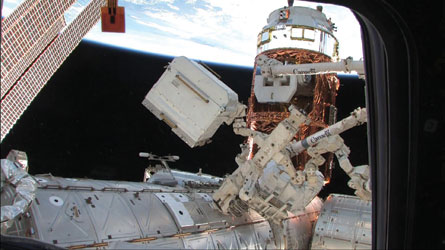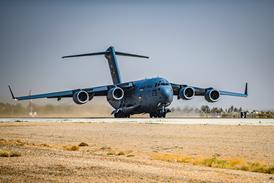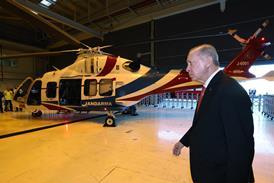Canada's contribution to aerospace ranges from the highly visible - Bombardier regional jets and turboprops and Learjet, Challenger and Global business jets, and the Canadarm robotic arm on the International Space Station - to more hidden assets such as CAE simulators or Héroux-Devtek landing gear and other components and subassemblies.
Indeed, according to Aerospace Industries Association of Canada (AIAC) president Claude Lajeunesse, while 47% of the world's 20- to 90-seat regional aircraft are made in Canada, it is important to note other major contributions: small gas turbines (34%), commercial simulators (80%), commercial helicopters (14%), landing gear (31% - and 60% for new large aircraft landing gear) and transport aircraft environmental controls and onboard systems (60%).
 |
|---|
©NASACanada's contribution to global aerospace includes the Canadarm ISS robotic arm |
Lajeunesse is quick to point out that Canada's aerospace sector is the world's fifth largest, behind the USA, France, Germany and the UK, and employs more than 80,000 people directly. And, he says, the sector has momentum and deserves the support it gets from the government, noting for example the Lockheed Martin F-35 programme: "Thanks to our world leadership in several subsectors, Canada is in a position to secure a very significant share of work on this state-of-the art aircraft."
But while Canada clearly holds its own in global aerospace, figures show the industry is far more important to Canada than to many of its rivals. According to an October 2010 Deloitte & Touche study carried out for the AIAC, The Strategic and Economic Impact of the Canadian Aerospace Industry, based on both aerospace industry revenues and employment compared with GDP, Canada ranks second among the top five aerospace countries, behind France but ahead of the US, the UK and Germany.
MANUFACTURING
In 2009, the aerospace sector generated directly some C$10.4 billion ($10.8 billion) in GDP, or about 6.9% of Canada's total manufacturing GDP. Including indirect impact, the sector's total value to the Canadian economy was about C$17.5 billion according to Deloitte or C$22.2 billion by the AIAC's measure. The aerospace industry provides nearly 80,000 jobs directly in Canada, and nearly that many again indirectly, and 80% of sales are exports.
And, says Deloitte, research and development spending by the aerospace sector plays a critical role in the Canadian economy, with Pratt & Whitney Canada, Bombardier and CAE among the 19 Canadian companies which spent more than C$100 million on R&D in 2009. Aerospace companies may account for one-tenth of total R&D spending by Canadian companies.
One significant characteristic of the Canadian aerospace industry - and one that may prove advantageous in the coming years of military spending cutbacks - is the fact that it operates mostly in the civil sector, which is unsurprising given Canada's relatively modest defence spending.
According to Deloitte, in 2009 civil spending accounted for an estimated 83.4% of Canadian aerospace revenue.
In 2009, Canada's $20.5 billion of military spending represented 1.3% of GDP - compared with 4.3% in the USA.
Canada's place in world aerospace, however, is not assured. According to the most recent AIAC members' survey, nearly half of respondents expect to lose a significant proportion of their business to developing aerospace markets.
This result may be no surprise, and it is interesting to note that when it comes to growth prospects within Canada, smaller companies are more optimistic than larger ones.
But what is clear is that a robust relationship with developing countries is seen as critical by Canada's aerospace sector.
The AIAC survey also reveals that Canadian companies regard access to a cost-efficient supply chain as important, and respondents highlighted the need to increase the maturity of their supply chains in low-cost countries. Canadian companies also recognise a need to move up the global supply chain. Deloitte identifies two keys to the future competitiveness of the Canadian aerospace industry.
One is R&D investment, which Deloitte sees as lagging behind France, Germany and the USA, and which may need to rise if Canada is to increase its global aerospace market share. Notably, says Deloitte, R&D investment from public funds needs to rise substantially if Canada is to match the relative input of the US public sector.
Secondly, Canadian aerospace companies, and the government, must adopt "aggressive emerging market strategies" to take advantage of these high-growth markets, which will not be able to meet their domestic demand from locally supplied products. That is, developed countries should be able to drive revenue growth by filling the gap between passenger growth and aircraft manufacturing growth in developing countries.
Says Deloitte: "This gap represents an opportunity for the Canadian aerospace industry and a basis for shaping trade policies."
Source: Flight International




















